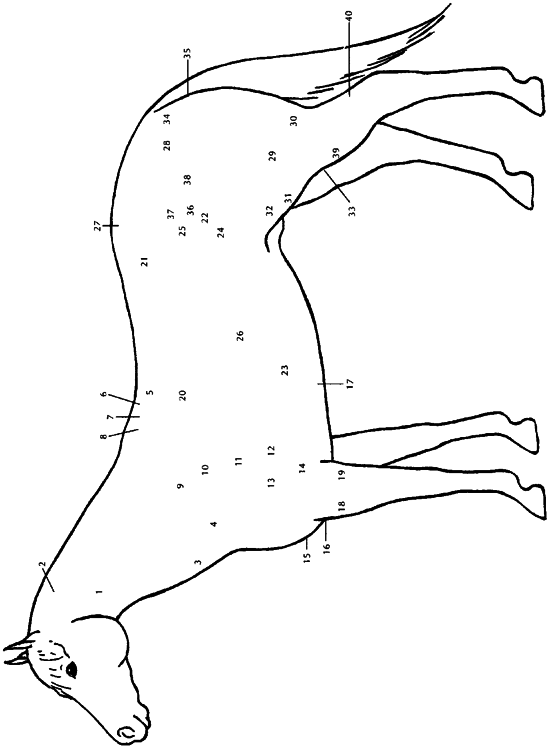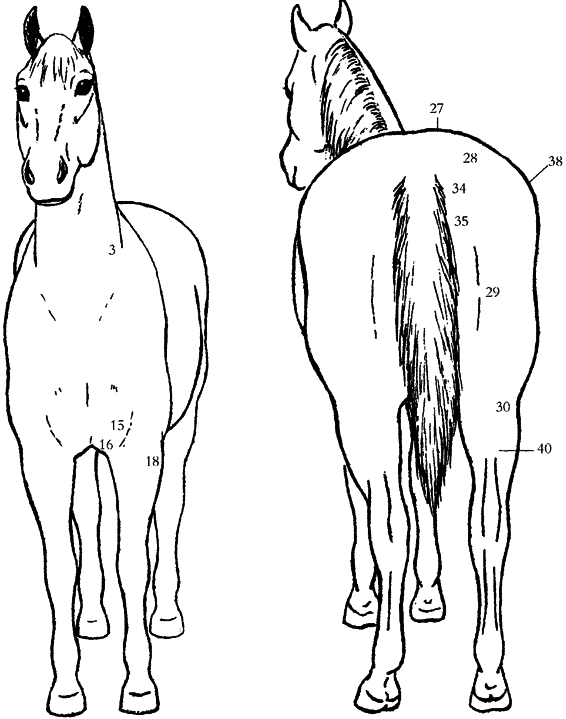Equine Massage: A Practical Guide (41 page)
Read Equine Massage: A Practical Guide Online
Authors: Jean-Pierre Hourdebaigt

Stress point 40 will be felt as a rigid knot of tissues next to the attachment point on the fibula. It feels very tender to the horse.
The whole muscle might show tightness along its course.
Having a thorough knowledge of all the stress points found on the
body of the horse will contribute tremendously to the quality of
your massage work.
Stress Point Check-up
Routine
The stress point check-up routine is divided into three sequences.
But, before you start, to best evaluate potential stress point areas in your horse, take note of his history (type of training, accidents, traumas) and current training program (chapter 15). Keep in mind the horse’s conformation and way of going (chapter 9).Then, first evaluate all 40 stress points on each side of the animal to get direct feedback on your horse’s physiological state. This will tell you which part of the body needs emphasis. Second, using the stress point technique, work the whole body of the horse, spending more time on the areas showing active stress points.
Finally, go over the whole horse again, strongly emphasizing drainage. Remember to use hydrotherapy (cold application) over tender stress points when needed. Complete your work with a thorough stretching routine.
It took a certain amount of time for these stress points to develop, so it will probably take a few treatments before you see full recovery. Be patient; you will see improvement right from the start of your massage.
Take notes so that you can assess the progress of your work and its effect on the horse.After your first evaluation, you can consider giving small local treatments of 20 to 30 minutes to the most

228
Equine Massage
View
Side t,
tion Char
oint Loca
ess P
Str
10.9
Body Parts and Their Stress Points
229
(continues)
d
d
d
eleg
ar
ar
ar
ds (adjustment)
events dislocation
ar
pr
lifts for
unk upw
ds and backw
ds and backw
ds and backw
events dislocation
vement,
ar
ar
ar
pr
ws tr
w joint
vement
vement
rotates head to opposite side
forw
forw
forw
dra
vement
,
ds
vement
t
ds,
ds,
ds,
ds,
ar
ar
ar
ar
ar
d
ing mo
ing mo
ar
ing mo
ing mo
rotation of shoulder joint,
UNCTION
eleg dur
eleg dur
F
eleg backw
ays head and neck mow
s scapula backw
es neck to the side
ws scapula upw
ws scapula upw
ws scapula upw
ws leg backw
es shoulder joint
ws for
es hoof dur
USCLE
raw
M
Flexion and lateral flexion of the head
Lateral flexion of the head
Side
Flex
Extends the back
Dra
Dra
Dra
Extension of shoulder joint,
Abduction,
D
Dra
Flex
Extends and locks the elbo
Adducts for
Adducts for
Dra
Extends hoof dur
Flex
sclesu
yoid m
uscles
uscles
uscles
uscle
uscle
uscle
uscle
uscle
uscle
General Stress Point Char
uscle
uscle
uscle
uscle
rate m
uscle
uscle
entralis m
uscle
uscle
uscle
yoid and omoh
si m
t of ser
er end) m
AME
vicis m
si m
oh
w
pal flexor m
N
pal extensor m
yr
us dor
noth
USCLE
riceps (upper end) m
riceps (lo
M
Rectus capitis v
Splenius cer
Brachiocephalic m
Ster
Spinalis dor
Rhomboids and trapezius m
Rhomboids and trapezius m
Rhomboids and trapezius m
Supraspinatus m
Infraspinatus m
Thoracic par
Latissim
T
T
Cranial superficial pectoral m
Caudal superficial pectoral m
Caudal deep pectoral m
Radial car
Lateral car
1.
2.
3.
4.
5.
6.
7.
8.
9.
10.
11.
12.
13.
14.
15.
16.
17.
18.
230
Equine Massage
dar
otates leg inw
d
d attachment) flexion
ar
ar
ib cage attachment)
d
es stifle and r
ar
flex
lateral (forw
unk
otates thigh outw
flexion of stifle joint
ur
ur
rotates thigh outw,
UNCTION
opulsion
F
unk straight and laterally (hip attachment)
unk straight and laterally (r
unk straight and laterally
unk straight and laterally
unk straight and laterally
d pr
es tr
es tr
es tr
es tr
es tr
ar
es the stifle and the hock joint
es hip joint and extends stifle
es hip joint and r
es the hoof
USCLE
orw
M
Extends back and loins,
Lateral flexion of the tr
Flex
Flex
Flex
Flex
Flex
F
Extends and abducts hind leg (hip and hock flex stifle) Flex
Extension of hock,
Flexion of hip/fem
Flexion of hip/fem
Adducts hind leg
Extends hip and hock joints;
Extends hip joint
Flex
Flex
Extends hip
Extends the hoof
Flex
t)
uscle
uscle
uscle
tion)
uscle
lique m
lique m
uscle
lique m
uscle
ur inser
uscles
uscle
uscle
uscle
uscle
uscle
uscle
ib) m
uscle (stifle)
uscle
si m
uscle
uscle (belly par
uscle
uscle (stifle)
si m
is m
is m
is m
uscles (fem
AME
N
us dor
se abdominal m
astus m
asciae latae m
uscle
ital extensor m
ital flexor m
er
issim
nal abdominal ob
nal abdominal ob
nal abdominal ob
costal (10th r
ocnemius m
USCLE
ransv
ensor f
M
Long
Iliocostalis dor
Exter
Exter
Inter
T
Inter
Junction of gluteus m
Biceps femor
Biceps femor
Gastr
Lateral v
Rectus femor
Adductor m
Semitendinosus m
Semimembranosus m
T
Iliacus m
Superficial gluteus m
Long dig
Long dig
20.
21.
22.
23.
24.
25.
26.
27.
28.
29.
30.
31.
32.
33.
34.
35.
36.
37.
38.
39.

Body Parts and Their Stress Points
231
10.10 Stress Point Location Chart, Front/Rear View
active stress points in order to provide relief. Hydrotherapy (chapter 4) and stretching exercises (chapter 8) are useful additions to these short treatments.
A thorough knowledge of these 40 stress points will allow you to make more accurate evaluations and thus ensure better treatments. Remember that the whole muscle structure of the horse works simultaneously and that consequently you will most likely find more than one stress point.
232
Equine Massage
First Sequence
After applying a relaxation massage routine, use light strokings or effleurages to go from point to point, evaluating all 40 points in approximately 10 minutes. Palpate lightly with the tip of your thumb or fingers to determine the degree of tension and inflammation (if any heat or swelling is present) at each point.
Remember the four T’s—tension, texture, tenderness, and temperature. As you go along, note the areas that need work. At the end of this pass, record your findings to remind yourself of the area that will need more attention.
The Head and Neck
Use gentle muscle squeezing. Start with the ears, massaging thoroughly from the poll down (a few inches) to the throatlatch. Feel the transverse processes of the cervical vertebrae and check if the vertebrae are aligned. Then flow into strokings or effleurage to check the stress points and the main muscles that attach to the head: the rectus capitis ventralis (SP 1), the splenius muscle (SP 2), the brachiocephalic muscle (SP 3), the sternothyrohyoid and omohyoid (SP 4), and the ligamentum nuchae (nuchal ligament).
The Shoulder
With gentle muscle squeezing, check the stress points over the withers (SP 5 to 8). Then with light stroking go down over the scapula to check stress points related to that bone (SP 9 to 11).
Flow over the triceps muscle to check its stress points (SP 13, 14) and the one pertaining to the latissimus dorsi (SP 12). Stroke gently to the front of the shoulder to check the pectoral muscle and its stress points (SP 15 to 17). Keep stroking down the leg to check the flexor and extensor of the foreleg (SP 18, 19).Assess the joints with a light palpation. Look for any inflammation, swelling, or abnormal bone formations.Then weave your strokes into light effleurages going up the leg, over the shoulder, and up to the withers.
The Back and Chest
Continue with some gentle strokings to assess the back muscles, the longissimus dorsi and iliocostalis dorsi muscles (SP 20, 21).
Weave your strokes to the abdominal muscle, the internal and external oblique muscles, and the intercostal muscles (SP 22 to 26).
Body Parts and Their Stress Points
233
The Hindquarters and Hind Legs
Follow with strokings to the muscles of the hindquarters, starting with the gluteus maximus (SP 27). Move to the semitendinosus and the semimembranosus muscles (SP 34, 35), the biceps femoris (SP 28, 29), and the gastrocnemius (SP 30). Gently go over the stifle area to check the quadriceps group of muscles, especially the vastus lateralis (SP 31,).Then gently effleurage on the inside leg to check the adductor group (SP 33). Continue by stroking down to the long digital extensor and long digital flexor muscles (SP 39, 40). From there, effleurage up the leg all the way to the flank, where you will check the iliacus, the tensor fasciae latae and the superficial gluteus muscles (SP 36 to 38). Weave some gentle strokes back to the withers and up the neck.
This completes the first side. Duplicate your assessment routine on the other side of the animal.
